In 2004 Chris Santella wrote his book Fifty Places to Fly Fish before You Die. It sold 100 000 copes and he has since written a sequel - Fifty More Places to Fly Fish before You Die.
As Al Spaeth and I drove back to Somerset East in mid-January after spending a few days at Sterkfontein Dam near Harrismith in the Orange Free State, it struck us that the SA Tourist Association should sponsor a trip to Sterkies for Chris Santella.
Click in images to enlarge

Sterkfontein Dam landscape. Photo by Gerhard Laubscher
We all have our fly fishing bucket list and Santella covers all the bases; bonefish on Christmas Island, tarpon in Cuba, the Ephemera Danica hatch on the River Test, Giant Trevally in the Seychelles, salmon in Norway, Taiman in Mongolia and the giant trout in Patagonia’s Jurassic Lake. If you have the money, Frontier Fly Fishing and other outfitters will gladly organise a guided trip for you but, believe me, if you want world class fly fishing, you need look no further than Sterkies.

The author Alan Hobson with a 6lb fish caught on 8X Nano Mono on this trip to Sterkfontein
To see so many spooky fish in such clear water, the vigour with which they strike if the presentation is right and the way in which the line then smokes off the reel is an unforgettable experience.
Meeting the Good Doctor
Al, my long-time friend and companion on this trip, is a beetle junkie, a fervent disciple of the Good Doctor’s Beetle as he believes that few fish can resist this chunky, protein-filled terrestrial and he proves it regularly in the spectacular barbel fishing that Somerset East provides
http://www.tomsutcliffe.co.za/fly-fishing/friend-s-articles/item/880-barbel-on-beetles-by-ed-herbst.html
We were privileged on this trip to meet the inventor of this fly, the “Good Doctor”, Hans van Zyl, to learn from his observations and to hear about the development of the pattern.
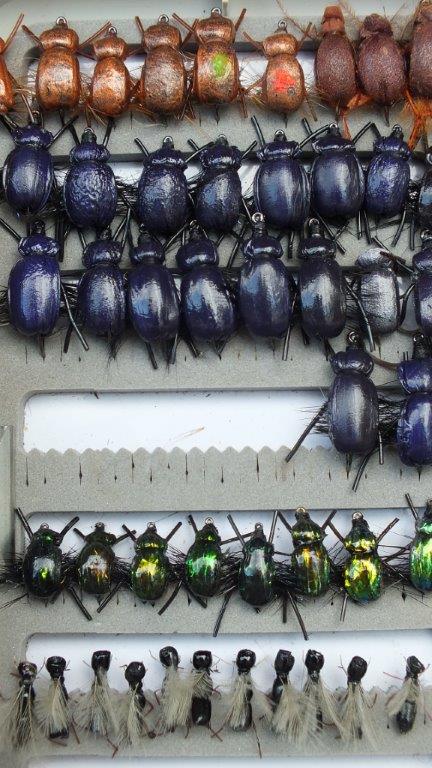
The Good Doctor’s renowned Beetle
Suffice it to say, his innovative use of “Seal Skin” has taken dry flies to another level. Ed Herbst has sketched the background to what is a staple at Sterkfontein, but it was good to meet Hans in person and to share thoughts on fly patterns.
http://www.tomsutcliffe.co.za/fly-fishing/fly-tying/item/228-the-good-doctors-beetle.html
What was interesting on this trip was the three methods we adopted.
Beetle fishing
The beetle fishing is always exciting, as the yellowfish absolutely smash it, but don’t get hooked easily. The one thing Hans emphasized is that you should not strike when you see the take. Instead, wait for the line to go taut and then, and only then, gently lift into the fish. Such is the gusto with which the yellow takes the fly and such is the speed at which it swims, that they invariably hook themselves.
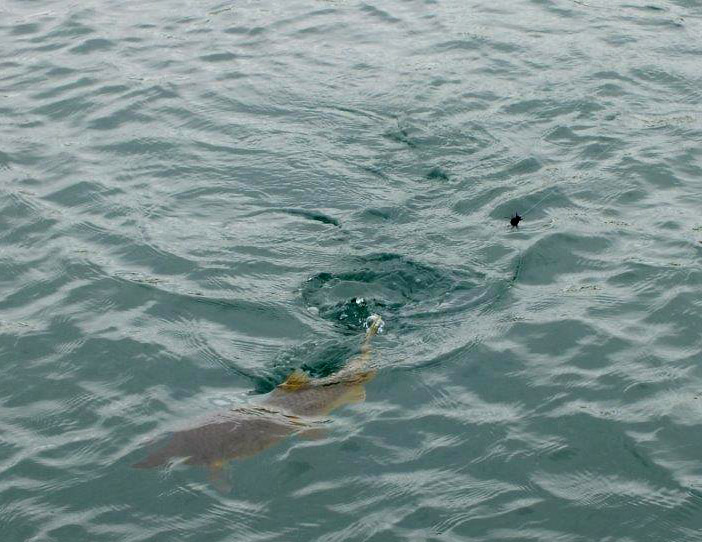
Such is the gusto with which the yellow takes. This time the dropper off a dry
They often miss the beetle and by striking you remove it from the strike zone. If you leave it there and stay in touch with the fly the fish more often than not comes back. Strangely every time we got to a fishing spot we would catch two or three fish on the beetle and then the activity and enthusiasm would quieten down considerably.
I would then change to nymphing, something Al was very hesitant to try at first. Eventually, on day four, I persuaded him to stand next to me and to try the method. Needless to say he is now addicted, - who said you can’t teach an old dog new tricks?
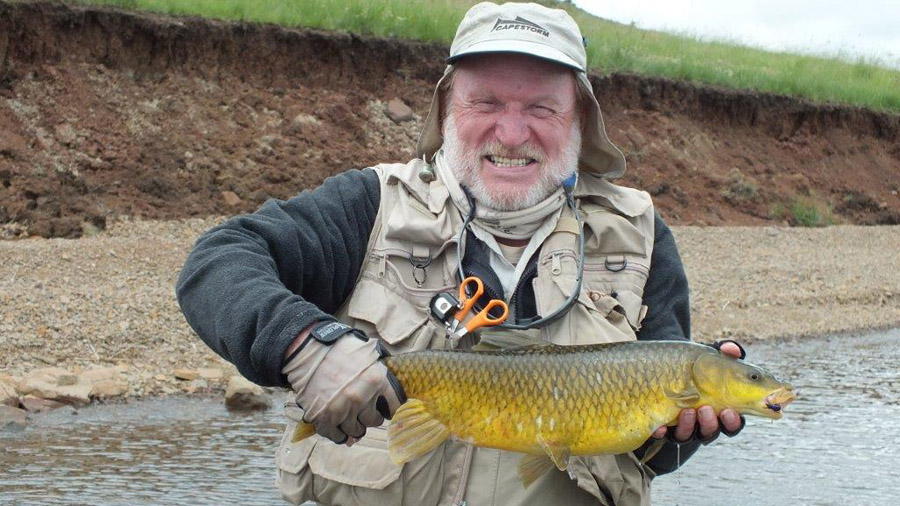
Al Spaeth with 9lb fish 65cm long, 12cm wide and girth of 30cm, fish of the trip!
Nymphing leaders
The leader set up and fly size were critical to our success. I built my own leader for this trip. It comprised a butt section of 12lb monofilament connected to 10lb fluorocarbon, 10lb mono, 7lb mono, 5lb mono and 3lb fluorocarbon to a length of about twelve feet. The reason why I combined both types of nylon was to get the leader to sink – an essential factor in water that clear. What was fascinating was the fact that if my piece of 5lb mono was longer than twelve inches and the tippet of 3lb fluoro, (Vision Prisma 7X, 0,125mm diameter), was longer than eight inches I would get broken off literally on every take. I also experimented with 8X Vision Nano monofilament, 2,2 lb. test, with a diameter of 0,09mm and managed to land a few fish up to 6lbs.
I found the short tippet to be more forgiving with a decent amount of shock absorption and a much higher success rate in hooked fish.
Micro nymphs

Selection of tiny nymphs
The size of the flies had to be #16 or smaller and the most successful were a series of “Phantom Emergers” I had developed in different colours. There are two versions, each tied on the #18 Orvis straight eye Big Eye Hook.
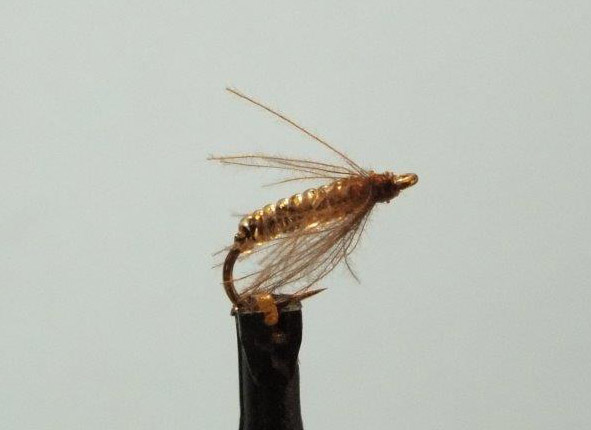
Phantom Emerger #18 (old Gold)
In each case the top layer is fine vinyl D rib and the hackle a turn of natural CDC. The first version uses Uni Micro-Tinsel Old Gold, which combines a fine gold and black tinsel into a single 6/0 thread.
http://www.fishing-mart.eu/sklep/en/tinsels-wires-leads-uni-micro-tinsel-g6-a213-p1367-k8905.html
The second uses Veevus Rainbow Iridescent thread

Phantom Emerger #18 with hot spot wing case
http://veevus.com/iris-thread/16-iris-thread.html
The standard PTN #20 was also deadly.
Nymphing while wading
We would wade into the water up to about waist deep, about five metres from the bank and then turn around and cast back to or parallel to the bank to nymphing or cruising fish. The trick was short, sharp figure-of-eight twitches but if you reacted to a visual take with a conventional strike, no matter how gentle, you were broken off.
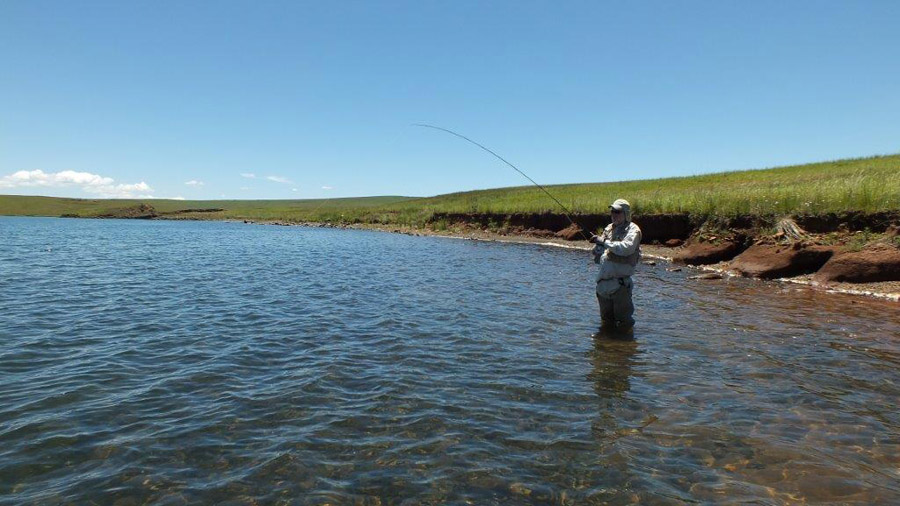
Nymphing off the bank
As soon as you feel anything, or in some cases when we were sight fishing, if you noted the slightest change in the body language of the fish, you gently lift the rod tip to slightly increase the leader tension. The fish tear off into the deeper water and the drag on the line and the angle of the rod would then set the hook. To successfully land fish on such fine tippets it is imperative to pre-set the drag on your reel. This protects your tippet on that initial “lift off” and when the fish keeps darting away to avoid the net at the end of the fight. This is where the money invested in a reel with a quality drag system pays substantial dividends. I unequivocally commend Shilton whose SL5 model played a big role in the number of fish that Al and I landed in conditions where a silky drag and low start-up inertia are the difference between heady success and disappointing failure.
Cliff fishing
The other successful technique was “cliff fishing”. This requires finding a high bank, usually around rocky outcrops and positioning yourself back from the edge about two metres above the water. This was dry and dropper fishing at its best - sight fishing that rewards casting accuracy and finesse. We looked for areas where we were not too far from a path down to the water which enabled us to land hooked fish. We would sit down, back from the bank with just the rod tip sticking over the edge. The setup was a twelve foot leader with 4lb tippet. The Good Doctors Beetle is very buoyant and does not get pulled down by the dropper fly, usually a “hot spot” nymph, but tiny, #18 or #20.
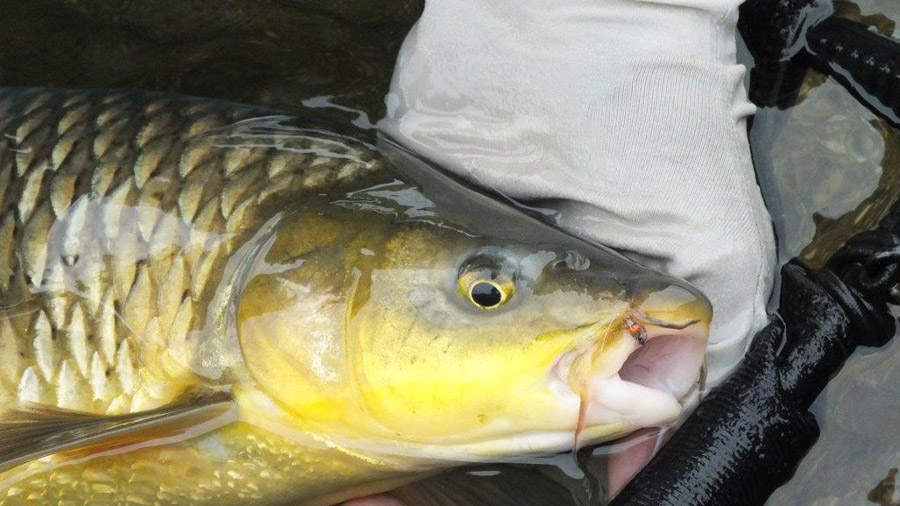
Sterkfontein yellow taken on a # 20 Hot Spot Soft Hackle
It pays to sit and observe the fish cruising/patrolling the edges to see at what depth they are swimming below the surface as this determines how long your dropper must be. It is tied New Zealand style to the bend of the Beetle’s hook. You want your dropper to be slightly higher than the depth the fish are swimming, as they are constantly looking up for the food being blown onto the surface or caught up in the scum lines. The yellows can mouth your dropper without moving the beetle, so don’t watch your indicator fly, rather watch the behaviour of the fish. At the slightest pause or tilt in the body of the fish, delicately incline the rod tip upwards and hold on, as they dive for the depths at super speed. Again, pre-set your drag. The casts are short; one needs no more than a metre of line out to get your flies into the cruising lanes and then you watch with great anticipation!
These techniques proved their worth – on our worst day Al and I caught a dozen fish each and our best days saw us each landing about 30.
We are blessed to have such a wonderful fishery on our doorstep.
Postscript by Ed Herbst: The late Harry Stewart, inventor of the deadly mink-hide based Millionaire’s Taddy, had a termite pattern which he used to great effect on his home water, Gubu Dam, near Stutterheim. Harry said that during termite flights the water would be carpeted with these insects and the trout would often turn on them, deliberately dousing it with water to subdue the insect and ensure capture. If you struck at the splash there was invariably nothing there and it was imperative to wait for the line to draw away which meant that the trout had returned and taken the termite which it now assumed to be dormant.



